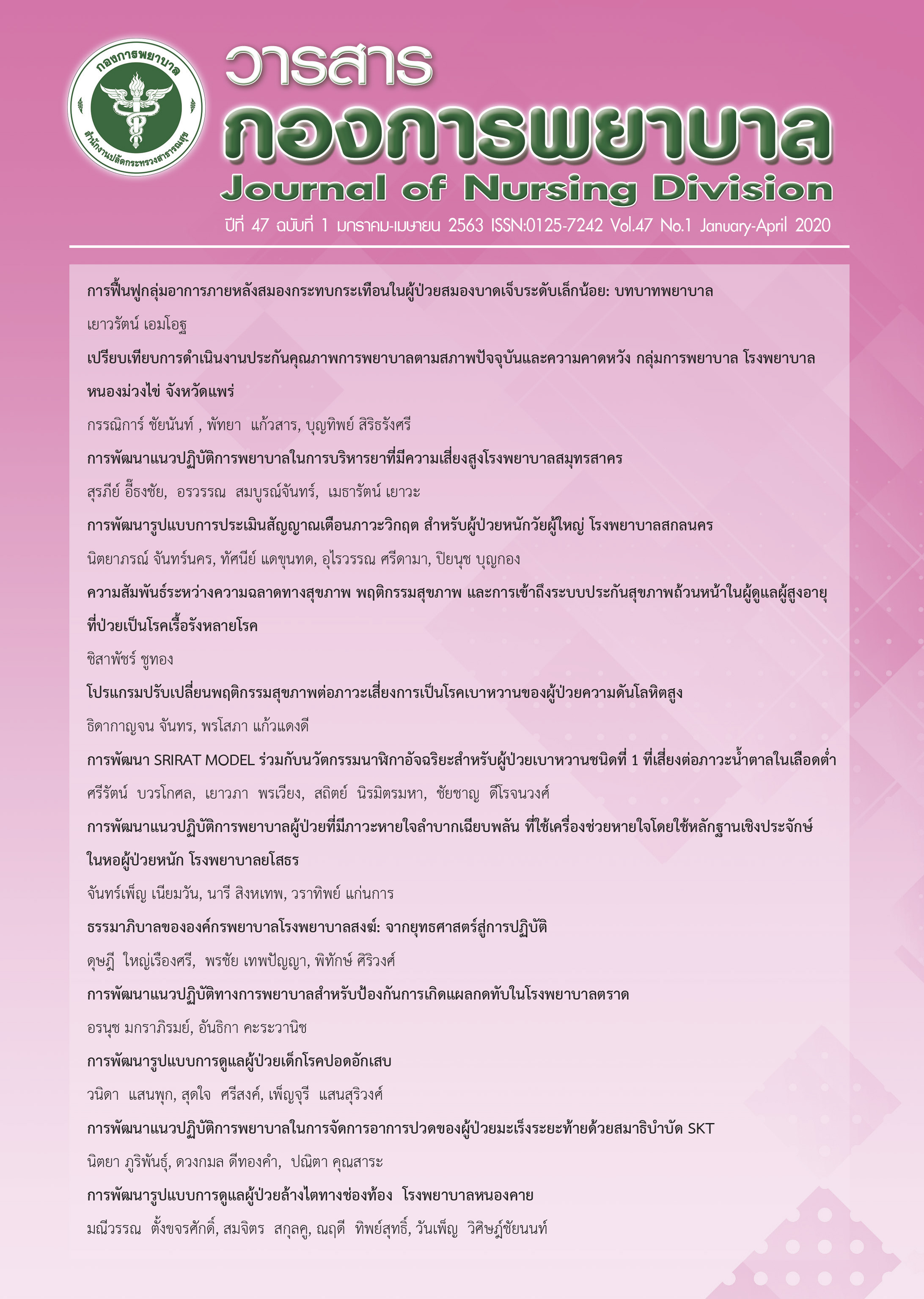การพัฒนารูปแบบการดูแลผู้ป่วยล้างไตทางช่องท้อง โรงพยาบาลหนองคาย
Main Article Content
บทคัดย่อ
การล้างไตทางช่องท้องเป็นการรักษาที่ต้องทำตลอดชีวิตโดยภาวะแทรกซ้อนที่พบบ่อยคือการติดเชื้อและภาวะน้ำเกิน การพัฒนารูปแบบการดูแลที่เปิดโอกาสให้ผู้ป่วยและพยาบาลมีส่วนร่วมในการตั้งเป้าหมายร่วมกัน ทำให้บรรลุผลลัพธ์การดูแลที่ดี การศึกษาครั้งนี้ มีวัตถุประสงค์ เพื่อพัฒนาและศึกษาผลลัพธ์การใช้รูปแบบการดูแลผู้ป่วยล้างไตทางช่องท้อง ซึ่งแบ่งเป็น 4 ระยะ: 1) วิเคราะห์สถานการณ์ 2) พัฒนารูปแบบ 3) ใช้รูปแบบ และ 4) ประเมินผลการใช้รูปแบบ กลุ่มตัวอย่างคัดเลือกแบบเจาะจง ประกอบด้วย: 1) ผู้ป่วยที่ได้รับการล้างไตทางช่องท้องนานอย่างน้อย 6 เดือน มีการติดเชื้อหรือภาวะน้ำเกิน 30 คน 2) ผู้ดูแล 30 คน และ 3) พยาบาล 15 คน เครื่องมือวิจัย คือ รูปแบบการดูแลผู้ป่วยล้างไตทางช่องท้อง ที่พัฒนาขึ้นตามทฤษฎีของคิง เครื่องมือเก็บรวบรวมข้อมูล ได้แก่ แบบบันทึกการติดเชื้อและน้ำเกิน แบบวัดคุณภาพชีวิต (9 Thai) แบบวัดความรู้และทักษะ แบบประเมินความพึงพอใจ และแบบประเมินความเหมาะสมของรูปแบบ เครื่องมือผ่านการตรวจสอบคุณภาพความตรงตามเนื้อหาโดยผู้เชี่ยวชาญและวิเคราะห์ค่าความเชื่อมั่น วิเคราะห์ข้อมูลด้วยสถิติเชิงพรรณนา และ paired t-test
ผลการศึกษา พบว่า รูปแบบการดูแลผู้ป่วยล้างไตทางช่องท้อง โรงพยาบาลหนองคาย มี 3 องค์ประกอบ: 1) พัฒนาเครือข่ายพยาบาล 2) พัฒนาแนวปฏิบัติ และ 3) ให้การพยาบาลตามทฤษฎีความสำเร็จตามจุดมุ่งหมายของคิง ผลลัพธ์การใช้รูปแบบ พบผู้ป่วยมีการติดเชื้อลดลงร้อยละ 40.0 ภาวะน้ำเกินลดลง ร้อยละ 33.3 คุณภาพชีวิตอยู่ในระดับดี คะแนนเฉลี่ยความพึงพอใจของผู้ป่วย ค่อนข้างสูง (mean = 90.5, SD = 4.26) ผู้ดูแล และพยาบาล มีความรู้และทักษะเพิ่มขึ้นอย่างมีนัยสำคัญทางสถิติ p<.05 และ p<.01 ตามลำดับ รูปแบบที่พัฒนาขึ้นนี้ ส่งผลดีต่อผู้ป่วย และการบริหารบุคลากรที่มีจำนวนจำกัด จึงควรขยายผลการใช้รูปแบบสู่การดูแลผู้ป่วยโรคเรื้อรังอื่นๆ ทั้งในคลินิกและชุมชนต่อไป
Article Details
เอกสารอ้างอิง
[cited 2016 Dec 14]. Available from: http: //www.kdf.nhso.go.th/. Thai.
2. Liu FX, Gao X, Inglese G, Chuengsaman P, Pecoits-Filho R, Yu A. A global overview of the impact of peritoneal dialysis first or favored policies: An opinion. Perit
Dial Int. 2015;35(4):406–20.
3. Ardkhitkarn S. Self-management behavior predictors of chronic obstructive pulmonary disease in elderly patients with chronic renal failure [dissertation].
Master thesis Faculty of Nursing, Faculty of Graduate Studies, Chiang Mai University; 2012. Thai.
4. National Health Security Office.CAPD report 2019. Bangkok: NHSO.[Internet]. [cited 2019 Oct 01]. Available from: http://www.kdf.nhso.go.th. Thai.
5. Higuchi C, Ito M, Masakane I, Sakura H. Peritonitis in peritoneal dialysis patients in Japan: A 2013 retrospective questionnaire survey of Japanese Society for
Peritoneal Dialysis member institutions. Ren Replace Ther. 2016;2(1):2-12.
6. Krittapong Somboon, Siriporn Kamsa-ard. Epidemiology and treatment outcome of peritoneal dialysis (PD)-related peritonitis. Mahasarakham Hospital
Journal. 2019;16(1): 13-21. Thai.
7. Dong J, Chen Y. Impact of the bag exchange procedure on risk of peritonitis. Peritoneal Dialysis International. 2010;30:440-7.
8. Mawar S, Gupta S, Mahajan S. Non-compliance to the continuous ambulatory peritoneal dialysis procedure increases the risk of peritonitis. International
Urology and Nephrology. 2011;44:1243-9.
9. Panida Theamjanya, Chommanard Wannapornsiri, Duangporn Hynutakung. Self-care of patients who had peritonitis from continuous ambulatory peritoneal
dialysis. Journal of Nursing and Health Sciences. 2011;5(3):92-103. Thai.
10. Figueiredo AE, Bernardini J, Bowes E, et al. A syllabus for teaching peritoneal dialysis to patients and caregivers. Peritoneal Dialysis International Journal of the
International Society for Peritoneal Dialysis. 2016;36(6):592-605.
11. Siriluk Thongtong. Nursing role in supporting self-management of continuous ambulatory peritoneal dialysis patients. Journal of Health Research and
Innovation. 2018;1(1):46-57. Thai.
12. Figueiredo A, Goh BL, Jenkins S, et al. Clinical practice guidelines for peritoneal access. Peritoneal Dialysis International. 2010;30:424-9.
13. King IM. A theory for nursing: System, concepts, process. New York: Wiley Century-Crofts; 1981.
14. Rerngrit Thongyu, Duangporn Piyakong, Somluk Tepsuriyanont. The effect of the mutual goal setting nursing program on activities of daily living among
patients with stroke. Journal of Health Nursing and Health Care. 2019;37(2):103-12. Thai.
15. Jintanaporn Prasomsri. The consequence of nursing care based on The King’s theory goal attainment on food consumption behavior in chronic kidney
disease patient receiving continuous ambulatory peritonitis (dissertation); 2013. Thai.
16. Dialysis unit, Nongkhai Hospital. Patient registration; 2019. Thai.
17. Cheawchanwattana A, Manyuen S. The development of quality of life database software for use at renal disease clinics. Srinagarind Med J. 2018;33(4):359-63.
Thai.
18. Cheawchanwattana, A, Chanlertrith, D. Predictive criterion validity of a health-related quality of life 9-Thai by predicting survival rates in dialysis patients.
Journal of Nurses’ Association of Thailand, North-Eastern Division. 2012;30(2):23-33. Thai.
19. Siriluk Thongtong. Nursing role in supporting self-management of continuous ambulatory peritoneal dialysis patients. Journal of Health Research and
Innovation. 2019;1(1):46-57. Thai.
20. Sukanya Uengtrakul, Supannee Tangpukdee, Juthalak Kaewmafai. Development care services model for patients with end stage renal disease who received
the continuous ambulatory peritoneal dialysis at Roi-Et Hospital. Journal of Nursing and Health Care. 2014;32(4):49-59. Thai.
21 Mudjalin Buno-pash, Thassana Nilpha. The development of a caring model for patients with end-stage renal disease on continuous ambulatory peritoneal
dialysis by registered nurses in region 11’s health care network. Region 11 Medical Journal. 2015;29(1):1-11. Thai.
22. Nonglak Tengprawat, Lakana Sornsurin, Sunanya Phromtuang. Development of nursing care system for end stage renal disease patient with continuous
ambulatory peritoneal dialysis (CAPD). Medical journal of Srisaket Surin Burirum Hospital. 2017;30(3):135-46. Thai.
23. Kitima Setboonsrang, Prasert Prasomrak. The care model development for end stage renal disease patient who had renal replacement therapy on self-care
and quality of life in Loengnokta Crown Prince Hospital, Yasothon province. Community Health Development KKU. 2016;4(4):485-503. Thai.
24. Supaporn Youdaeng, Boontip Siritarugnsri, Wisit Prasithsirikul. The development of a care management model for patients undergoing continuous
ambulatory peritoneal dialysis at hemodialysis unit in Bamrasnaradura Infectious Disease Institute. Journal of Health Science Research. 2019;13(1): 20-30.
Thai.
25. Ranee Annapanurak, Ananya Manit. Development of nursing service system among chronickidney disease patients receiving continuous ambulatory
peritoneal dialysis by using case management concept at King Narai Hospital, Lop Buri. Thai Journal of Cardio-Thoracic Nursing. 2015;26(1):133-47. Thai.


